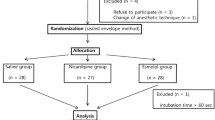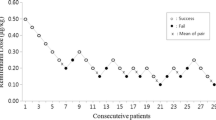Abstract
Purpose
The purpose of this study was to investigate the effect of ketamine on intubating conditions for tracheal intubation during anesthesia induction with sevoflurane and alfentanil in pediatric patients.
Methods
After obtaining parental consents, 50 children, aged 3–10 years, were randomly allocated into two groups to receive either i.v. ketamine 0.5 mg/kg (ketamine group, n = 25) or i.v. saline 5 ml (control saline group, n = 25). One minute after injection of the study drug (ketamine or saline), anesthesia was induced with 5% sevoflurane, followed by injection of alfentanil 10 μg/kg 1 min later. The trachea was intubated 4 min after inhalational induction of anesthesia. Acceptable intubation was defined as excellent or good intubating conditions. Mean arterial pressure (MAP) and heart rate (HR) were recorded during the induction period.
Results
The percentage of patients with acceptable intubating conditions was higher in the ketamine group (87%) than in the control group (52%) (P = 0.0129). MAP before intubation was significantly lower in the control group than in the ketamine group (P = 0.001).
Conclusion
This study demonstrated that administration of ketamine 0.5 mg/kg could improve intubating conditions for tracheal intubation without neuromuscular blockade and preserve hemodynamic stability during sevoflurane inhalation induction with alfentanil in children.
Similar content being viewed by others
References
Simon L, Boucebci KJ, Orliaguet G, Aubineau JV, Devys JM, Dubousset AM. A survey of practice of tracheal intubation without muscle relaxant in paediatric patients. Paediatr Anaesth. 2002;12:36–42.
Min SK, Kwak YL, Park SY, Kim JS, Kim JY. The optimal dose of remifentanil for intubation during sevoflurane induction without neuromuscular blockade in children. Anaesthesia. 2007;62:446–50.
Verghese ST, Hannallah RS, Brennan M, Yarvitz JL, Hummer KA, Patel KM, He J, McCarter R. The effect of intranasal administration of remifentanil on intubating conditions and airway response after sevoflurane induction of anesthesia in children. Anesth Analg. 2008;107:1176–81.
Soulard A, Babre F, Bordes M, Meymat Y, Sztark F, Cros AM. Optimal dose of sufentanil in children for intubation after sevoflurane induction without neuromuscular block. Br J Anaesth. 2009;102:680–5.
Kwak HJ, Kim JY, Min SK, Kim JS, Kim JY. Optimal bolus dose of alfentanil for successful tracheal intubation during sevoflurane induction with and without nitrous oxide in children. Br J Anaesth. 2010;104:628–32.
Solano AM, Pypendop BH, Boscan PL, Ilkiw JE. Effect of intravenous administration of ketamine on the minimum alveolar concentration of isoflurane in anesthetized dogs. Am J Vet Res. 2006;67:21–5.
Hendrickx JF, Eger EI II, Sonner JM, Shafer SL. Is synergy the rule? A review of anesthetic interactions producing hypnosis and immobility. Anesth Analg. 2008;107:494–506.
Topcuoglu PT, Uzun S, Canbay O, Pamuk G, Ozgen S. Ketamine, but not priming, improves intubating conditions during a propofol–rocuronium induction. Can J Anaesth. 2010;57:113–9.
Viby-Mogensen J, Engbaek J, Eriksson LI, Gramstad L, Jensen E, Jensen FS, Koscielniak-Nielsen Z, Skovgaard LT, Ostergaard D. Good clinical research practice (GCRP) in pharmacodynamic studies of neuromuscular blocking agents. Acta Anaesthesiol Scand. 1996;40:59–74.
Cheng EY, Mazzeo AJ, Bosnjak ZJ, Coon RL, Kampine JP. Direct relaxant effects of intravenous anesthetics on airway smooth muscle. Anesth Analg. 1996;83:162–8.
Gofrit ON, Leibovici D, Shemer J, Henig A, Shapira SC. Ketamine in the field: the use of ketamine for induction of anaesthesia before intubation in injured patients in the field. Injury. 1997;28:41–3.
Begec Z, Demirbilek S, Ozturk E, Erdil F, Ersoy MO. Remifentanil and propofol for tracheal intubation without muscle relaxant in children: the effects of ketamine. Eur J Anaesthesiol. 2009;26:213–7.
Hui TW, Short TG, Hong W, Suen T, Gin T, Plummer J. Additive interactions between propofol and ketamine when used for anesthesia induction in female patients. Anesthesiology. 1995;82:641–8.
White PF. Comparative evaluation of intravenous agents for rapid sequence induction-thiopental, ketamine, and midazolam. Anesthesiology. 1982;57:279–84.
Guit JB, Koning HM, Coster ML, Niemeijer RP, Mackie DP. Ketamine as analgesic for total intravenous anaesthesia with propofol. Anaesthesia. 1991;46:24–7.
Park KS, Park SY, Kim JY, Kim JS, Chae YJ. Effect of remifentanil on tracheal intubation conditions and haemodynamics in children anaesthetised with sevoflurane and nitrous oxide. Anaesth Intensive Care. 2009;37:577–83.
Bourgoin A, Albanèse J, Wereszczynski N, Charbit M, Vialet R, Martin C. Safety of sedation with ketamine in severe head injury patients: comparison with sufentanil. Crit Care Med. 2003;31:711–7.
Mayberg TS, Lam AM, Matta BF, Domino KB, Winn HR. Ketamine does not increase cerebral blood flow velocity or intracranial pressure during isoflurane/nitrous oxide anesthesia in patients undergoing craniotomy. Anesth Analg. 1995;81:84–9.
Kim JY, Kwak HJ, Kim JY, Park KS, Song JS. Prevention of rocuronium-induced withdrawal movement in children: a comparison of remifentanil with alfentanil. Paediatr Anaesth. 2008;18:245–50.
Author information
Authors and Affiliations
Corresponding author
About this article
Cite this article
Kim, K.S., Kwak, H.J., Min, S.K. et al. The effect of ketamine on tracheal intubating conditions without neuromuscular blockade during sevoflurane induction in children. J Anesth 25, 195–199 (2011). https://doi.org/10.1007/s00540-011-1092-9
Received:
Accepted:
Published:
Issue Date:
DOI: https://doi.org/10.1007/s00540-011-1092-9




